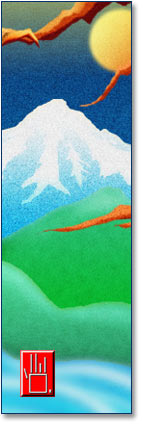On The Way: The Daily Zen Journal
Record of Things Heard – pt 2
Dogen (1200-1253)
The most important point in the study of the Way is zazen. Many people in China gained enlightenment solely through the strength of zazen. Some who were so ignorant that they could not answer a single question exceeded the learned who had studied many years solely through the efficacy of their single-minded devotion to zazen.
Therefore, students must concentrate on zazen alone and not bother about other things. The Way of the Buddhas and Ancestors is zazen alone. Follow nothing else.
At that time Ejo asked: “When we combine zazen with the reading of the texts, we can understand about one point in a hundred or a thousand upon examining the Zen sayings and koans. But in zazen alone there is no indication of even this much. Must we devote ourselves to zazen even then?”
Dogen answered: “Although a slight understanding seems to emerge from examining a koan, it causes the Way of the Buddhas and Ancestors to become even more distant. If you devote your time to doing zazen without wanting to know anything and without seeking enlightenment, this is itself the Ancestral Way.
“Although the old Masters urged both the reading of the scriptures and the practice of zazen, they clearly emphasized zazen. Some gained enlightenment through the koan, but the merit that brought enlightenment came from the zazen. Truly the merit is in the zazen.”
The basic point to understand in the study of the Way is that you must cast aside your deep-rooted attachments. If you rectify the body in terms of the four attitudes of dignity, the mind rectifies itself.
Students who have been moved to study the Way should merely follow the rest of the assembly in their conduct. Don’t try to learn the essential point and the examples from the past right away.
It is best, however, that they be fully grasped before you go alone to practice in the mountains or conceal yourself within a city. Students, even if you gain enlightenment, do not stop practicing, thinking that you have attained the ultimate. The Buddha Way is endless. Once enlightened you must practice all the more.
Every action of a person well versed in Buddhism shows deep thought, whether the action seems good or bad. This, ordinary people do not understand.
One day the Abbot Eshin asked a man to drive away a deer that was eating grass in the garden. At the time someone remarked, “You seem to have no compassion. Why have you begrudged the grass and tormented this animal?”
The Abbot replied, “You do not understand. If I did not chase the deer away, it would soon become accustomed to people. If it came near an evil person, it would surely be killed. That’s why I chased it away.”
Although chasing the deer seemed to show a lack of compassion, it was motivated by a deep compassion.
Dogen (1200-1253)
Excerpted from A New Zen Reader – ed by Nelson Foster and Jack Shoemaker




This piece is taken from the Shobogenzo Zuimonki which is different in purpose and scope than the Shobogenzo which is a more philosophical and abstruse text. This is a collection of informal talks as recorded by his student Ejo and considered to be more accessible offering practical guidance on practice.
The most important point in the study of the Way is zazen.
Here Dogen takes us right back to the heart of practice. The work of practice also includes that you must cast aside your deep-rooted attachments.
We can get the form of meditation easily enough. The work of letting go of attachments and the overbearing sense of self can take a lifetime.
Starting fresh each day,
Elana, Scribe for Daily Zen